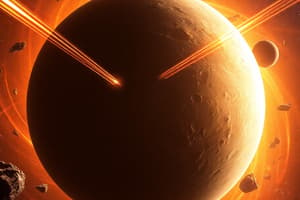Podcast
Questions and Answers
What is the primary composition of comets?
What is the primary composition of comets?
- Liquid droplets with frozen gases
- Gas giants with refractory grains
- Lumps of ice with small particles of dust (correct)
- Rocky particles with small amounts of ice
What happens to comets when they are heated by solar radiation?
What happens to comets when they are heated by solar radiation?
- They change color
- They become stationary
- They gain mass
- They lose matter (correct)
At what distance from the sun do comets typically spend most of their time?
At what distance from the sun do comets typically spend most of their time?
- Medium distances
- Great distances (correct)
- Close proximity
- Varies greatly
What is the characteristic of a comet's tail when it approaches the sun?
What is the characteristic of a comet's tail when it approaches the sun?
What is the difference between Type I and Type II comet tails?
What is the difference between Type I and Type II comet tails?
Which of the following is a characteristic of ion tails?
Which of the following is a characteristic of ion tails?
What is the classification of comets based on their period?
What is the classification of comets based on their period?
What is the ratio of Long Period to Short Period comets?
What is the ratio of Long Period to Short Period comets?
Flashcards are hidden until you start studying
Study Notes
Comets
- Comets are composed of ice, small particles of dust, and a mixture of frozen gases, carbonaceous particles, and refractory grains.
- They are primitive bodies of the Solar System.
- When heated by solar radiation, comets lose matter.
Cometary Behavior
- Comets spend most of their time at great distances from the Sun, appearing as a fuzzy patch of light.
- As they approach the Sun, their coma grows in size and brightness.
- A tail develops and reaches its maximum size at perihelion.
- As the comet recedes from the Sun, the reverse process occurs.
Cometary Structure
- Nucleus: small, typically a few kilometers in diameter.
- Coma: 10^4 to 10^5 kilometers in diameter.
- Head: consists of the nucleus and coma.
- Tail: 10^7 to 10^8 kilometers in length.
Types of Comet Tails
- Type I: Plasma/ion tail, resulting from the interaction of ions in the coma with the solar wind.
- Type II: Dust tail, composed of dust embedded in the nucleus.
Comet Tail Characteristics
- Ion tails are approximately straight and often made of glowing, linear streamers.
- Ion tails are more strongly influenced by the solar wind than the Sun's gravity, so they always point directly away from the Sun.
- Dust tails are slightly curved due to the heavier dust particles following the comet's orbit.
Classification of Comets
- Comets can be classified as New or Old.
- Comets can be classified based on their orbital periods:
- Short period (p < 200 years): e.g. Halley, Tempel 1, Tempel 2, Encke, etc.
- Long period (p > 200 years): e.g. Hale Bopp, Hayakutake, Levy Rudenko, etc.
- There are currently less than 1000 cataloged comets.
- The ratio of Long Period to Short Period Comets is approximately 5:1.
Studying That Suits You
Use AI to generate personalized quizzes and flashcards to suit your learning preferences.




